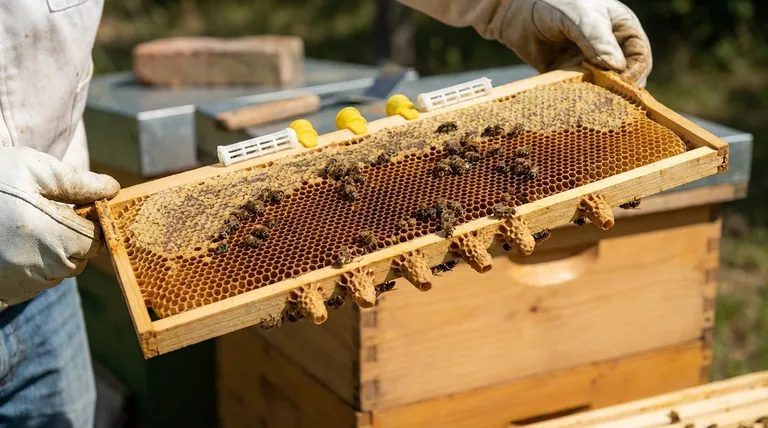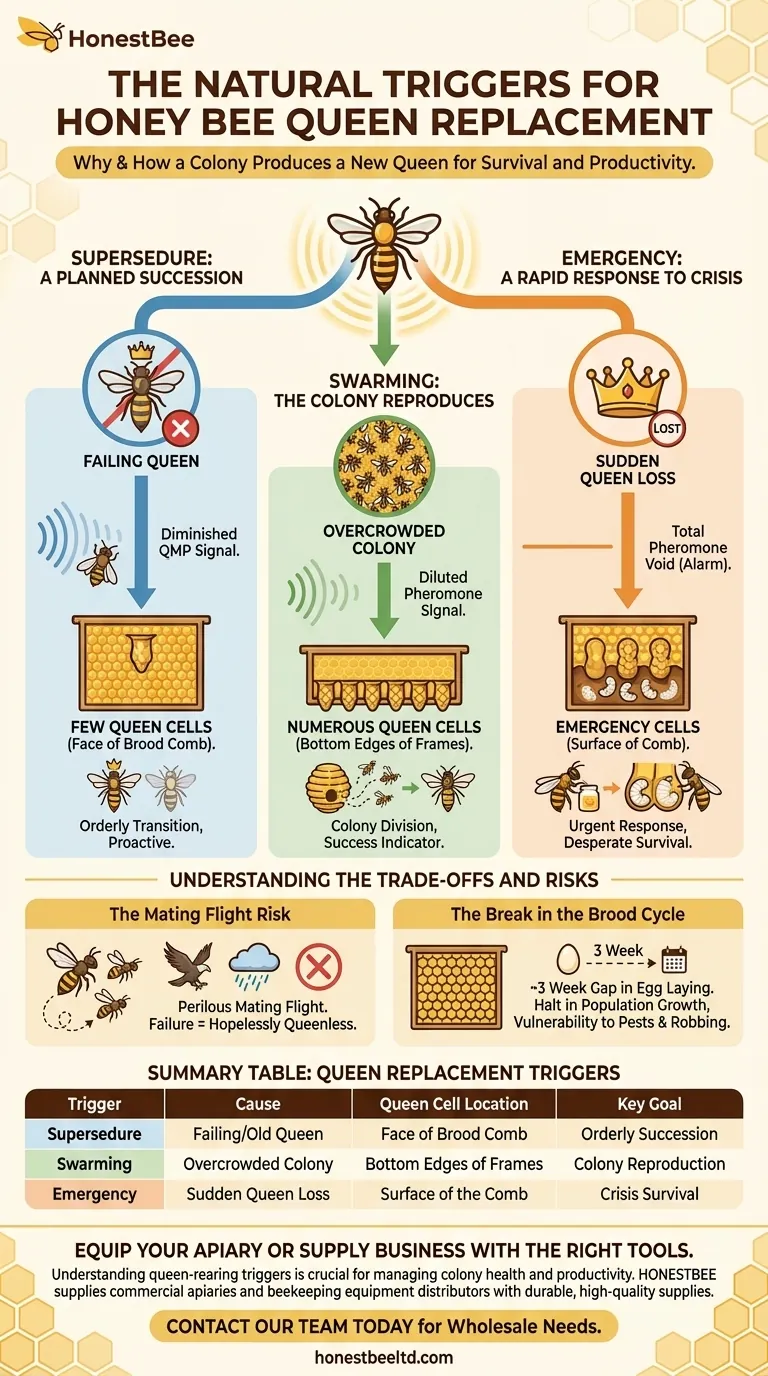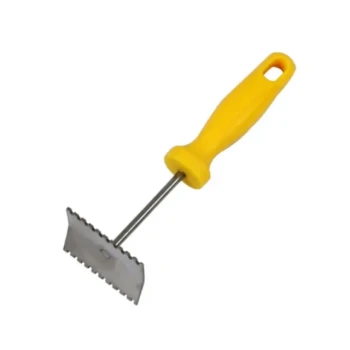In short, a honey bee colony produces a new queen for one of three reasons. This process is initiated when the existing queen is failing due to age or illness (supersedure), when the colony becomes too crowded and prepares to divide (swarming), or when the queen is suddenly lost or killed (emergency). These are not random events; they are precise, instinctual responses to specific signals that threaten the colony's long-term survival and productivity.
The decision to create a new queen is a collective one, made by the worker bees. It is triggered by a change in the chemical signals, or pheromones, that the reigning queen emits, signaling to the entire colony that a leadership change is necessary for its survival.

The Three Core Triggers for Queen Replacement
A colony's ability to replace its queen is one of its most remarkable survival mechanisms. While the specific circumstances differ, the end goal is always the same: to ensure the colony has a healthy, fertile, egg-laying queen to guarantee its future.
Supersedure: A Planned Succession
Supersedure is the colony's proactive and orderly process for replacing a failing queen. This is not an emergency but a carefully managed transition.
As a queen ages or becomes ill, her egg-laying rate declines and, critically, her production of Queen Mandibular Pheromone (QMP) diminishes. This pheromone is a vital "I am here and I am healthy" signal.
When the workers detect this weakening chemical signal, they begin preparations to raise a replacement. They will typically build a small number of queen cells, often on the face of the brood comb, and the new queen will hatch, mate, and take over egg-laying duties, sometimes even co-existing with her mother for a short time.
Swarming: The Colony Reproduces
Swarming is not a sign of failure but of success. It is the natural method by which honey bee colonies reproduce at the colony level.
When a hive becomes very strong and congested with bees and resources, the queen's pheromones become diluted and cannot reach every bee. This signals to the workers that the colony has the strength to divide.
In response, workers construct numerous queen cells, typically along the bottom edges of the frames. Just before the new queens are ready to emerge, the old queen will leave the hive with roughly half the bees in a swarm to establish a new colony elsewhere. A new virgin queen then hatches in the original hive to continue its legacy.
Emergency: A Rapid Response to Crisis
This is the colony's urgent, unplanned response to the sudden death or disappearance of their queen. Her abrupt absence creates an immediate and total loss of her vital pheromones.
This chemical void triggers an alarm. Worker bees scramble to select several existing female larvae that are less than three days old. They enlarge the wax cells around these larvae and begin feeding them an exclusive diet of royal jelly, which redirects their development from a worker bee into a queen.
These "emergency cells" look like peanut-shaped protrusions built directly on the surface of the comb and are a clear sign that the colony is in a desperate fight for survival.
Understanding the Trade-offs and Risks
While raising a new queen is essential, the process is not without its challenges. Understanding these risks is key to understanding colony health.
The Mating Flight Risk
A newly emerged virgin queen must leave the hive on a "mating flight" to mate with multiple drones in mid-air. This flight is perilous; she can be eaten by a predator, get lost, or encounter poor weather.
If she does not return, the colony has failed in its attempt and will become "hopelessly queenless," a condition from which it cannot recover without intervention.
The Break in the Brood Cycle
From the moment the old queen stops laying until the new queen successfully mates and begins laying her own eggs, there can be a gap of three weeks or more.
During this period, no new workers are being produced. This temporary halt in population growth can weaken the colony, making it more vulnerable to pests and robbing by other bees. The timing of this break can be especially critical depending on the season and nectar availability.
How to Apply This to Your Hive
Recognizing the signs of queen production is one of the most important skills a beekeeper can learn. Your response should be guided by what the bees are telling you.
- If you see supersedure cells: Your colony is likely handling its own needs. This is often a sign of a healthy, self-regulating hive, so observe carefully before intervening.
- If you see swarm cells: Your colony is strong and preparing to split. You can either let them swarm, or you can intervene by making a "split" yourself to manage your colony numbers and prevent losing bees.
- If you see emergency cells: You must first confirm the old queen is truly gone. If she is, the best course of action is usually to allow the bees to raise their new queen, ensuring they have the resources and protection to do so.
Understanding these natural triggers allows you to work with your bees' instincts, not against them, ensuring the long-term health and success of the colony.
Summary Table:
| Trigger | Cause | Queen Cell Location | Key Goal |
|---|---|---|---|
| Supersedure | Failing/Old Queen | Face of brood comb | Orderly succession |
| Swarming | Overcrowded Colony | Bottom edges of frames | Colony reproduction |
| Emergency | Sudden Queen Loss | Surface of the comb | Crisis survival |
Equip your apiary or supply business with the right tools for colony success.
Understanding queen-rearing triggers is crucial for managing colony health and productivity. HONESTBEE supplies commercial apiaries and beekeeping equipment distributors with the durable, high-quality supplies needed to support colonies through these critical natural events—from hive components for managing swarms to protective gear for hive inspections.
Let's discuss your wholesale needs. Contact our team today to ensure your operations are built on a strong foundation.
Visual Guide

Related Products
- Jenter Queen Rearing Kit Complete Set for Bee Breeding
- No Grafting Queen Rearing Kit: System for Royal Jelly Production and Queen Rearing
- Nicot Queen Rearing Kit for Beekeeping and Grafting in Nicot System
- Brown Nicot Queen Cell Cups for Breeding Queen Bees Beekeeping
- Retractable Chinese Queen Rearing Grafting Tools Equipment
People Also Ask
- How long does it take for a new queen to emerge, mate, and lay eggs? A Beekeeper's 10-14 Day Guide
- What are the stages involved in queen raising? A Guide to Controlled, High-Quality Queen Production
- What is queen rearing in beekeeping? Take Control of Your Apiary's Genetics
- How can beekeepers start a honey bee breeding program? Build a Superior, Resilient Apiary
- What happens to the colony population during the 5–6 weeks after a new queen emerges? Understand the Natural Dip and Rebound



















